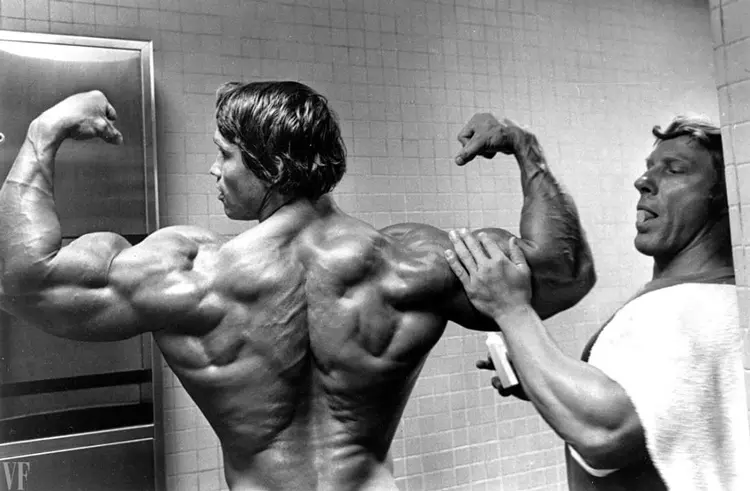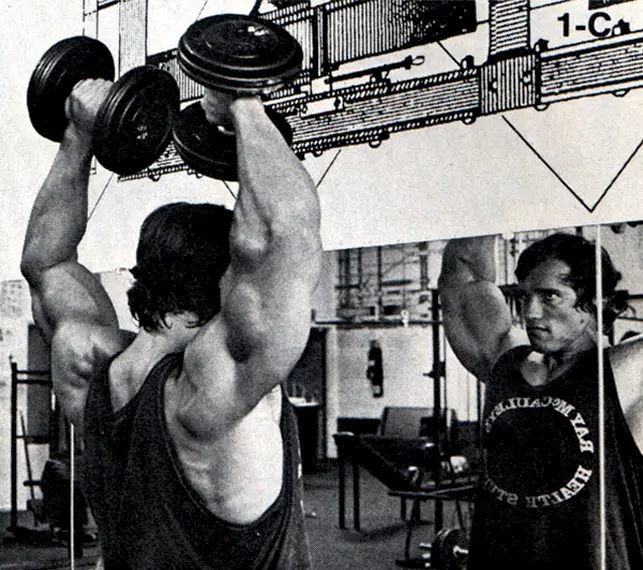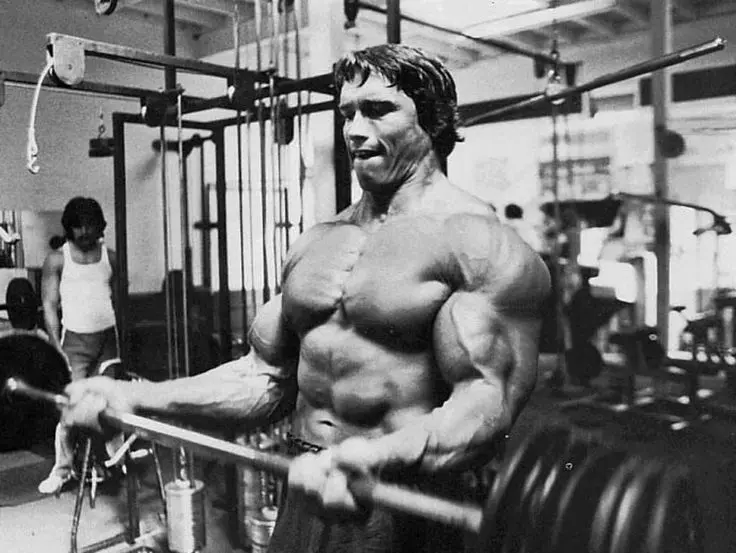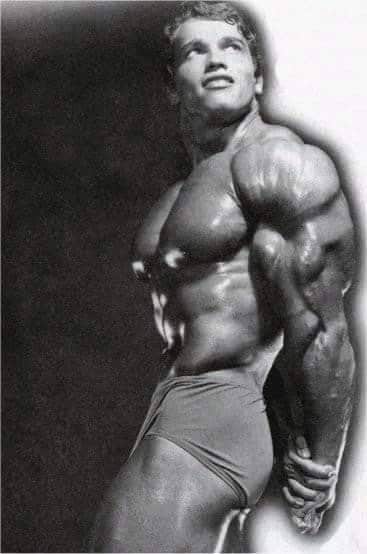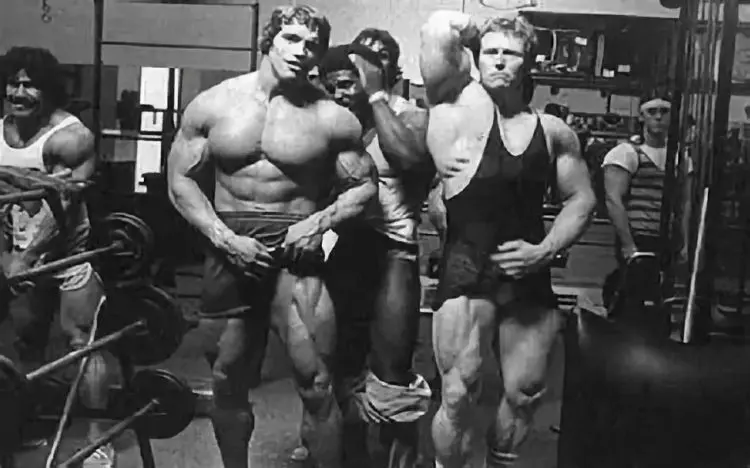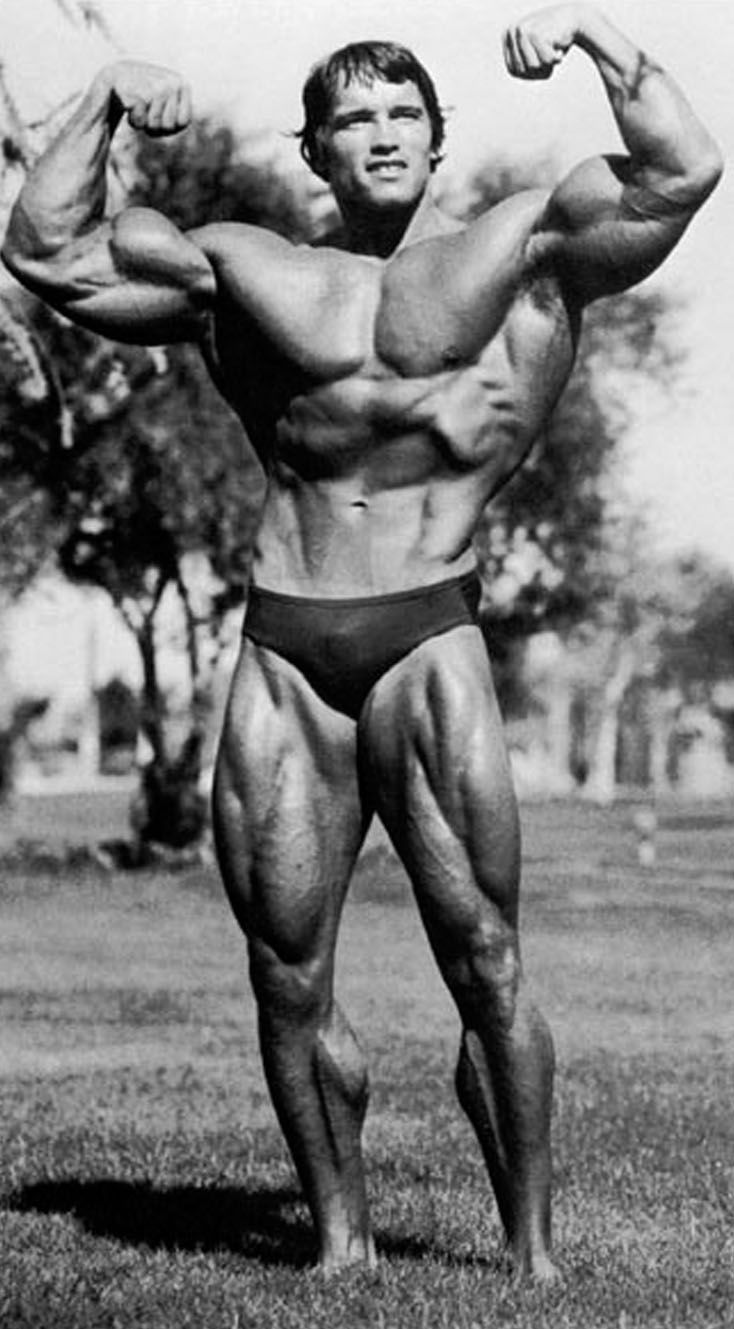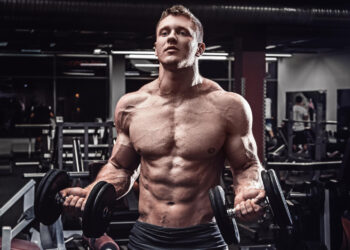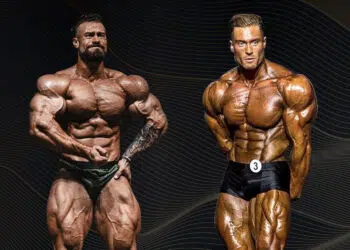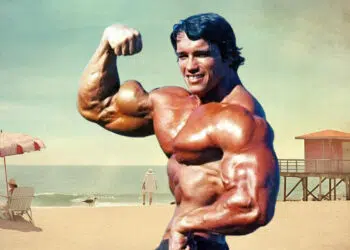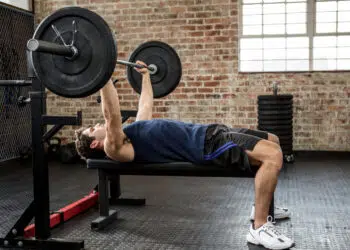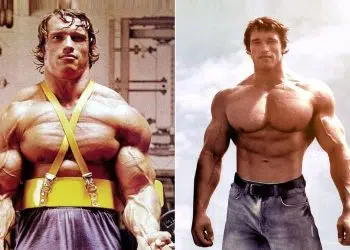More than forty years after he retired from the bodybuilding stage, Arnold Schwarzenegger remains the most popular bodybuilder on the planet. Today’s gym goers continue to draw inspiration from those iconic black and white photos of the Austrian Oak in his prime. And there is still a huge fascination with how he trained to create his amazing physique.
As a former gym owner and personal trainer, I can attest that most beginners joining gyms today still aspire to build a physique like ‘The Governator.’ It proves that the craze for Arnold’s aesthetics is growing with each day.
In this article, we drill down on the four-week Arnold split that he used in his prime. That takes us back to 1974, the year before he filmed Pumping Iron (1977). That was also before he slimmed down for his role in Stay Hungry. Bodybuilding historians agree that the best Arnold Schwarzenegger we ever saw was onstage at that 1974 Mr. Olympia at Madison Square Garden in New York.
4-Week Six-Day Arnold Split Workout Regimen
Here is the six-day training split Arnie used to build a Mr. Olympia-worthy physique:
- Monday: Chest, Back, and Abs
- Tuesday: Shoulders, Biceps, Triceps, Forearms, and Abs
- Wednesday: Quads, Hamstrings, and Calves
- Thursday: Chest, Back, and Abs
- Friday: Shoulders, Biceps, Triceps, Forearms, and Abs
- Saturday: Quads, Hamstrings, and Calves
- Sunday: Rest
4-Week Arnold Split By Muscle Group
Although Arnie trained multiple muscle groups in a single workout, we will go over his workout routine muscle-by-muscle to make things more convenient.
Chest
| Days | Exercise | Sets | Reps |
| Monday & Thursday | Bench Press | 6 | 30/20/12/10/8/6 |
| Incline Bench Press | 6 | 15/12/10/8/6/6 | |
| Superset: Dumbbell Flye and Pullover | 5 | 12 | |
| Dips | 4 | To Failure |
Arnold swore by the flat bench press as the cornerstone of his chest training. He also loved the incline bench press. He and Franco would pyramid down to heavy sets of six with around 400 pounds on the bench press bar; that was after already doing 5 sets of pyramiding down in reps.
Level Up Your Fitness: Join our 💪 strong community in Fitness Volt Newsletter. Get daily inspiration, expert-backed workouts, nutrition tips, the latest in strength sports, and the support you need to reach your goals. Subscribe for free!
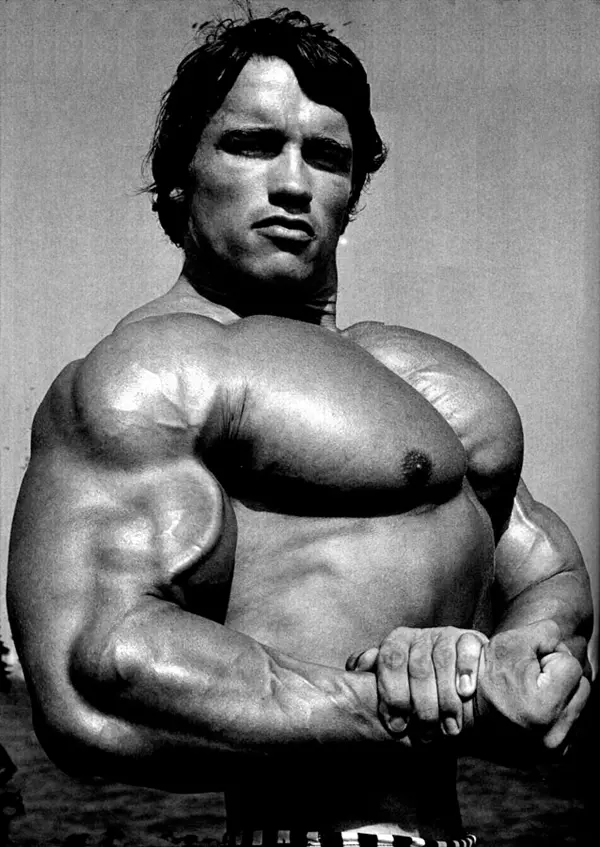
Flyers were another Arnold favorite. He believed that they were responsible for the width and sweep of his pecs. Super setting them with pullovers, Arnold believed, expanded his ribcage to create a wider chest.
Dips were used as a finishing exercise to pummel the chest into submission. Each set was done until another rep could not be squeezed out.
Arnold’s Keys to chest training:
- Grow with pyramids on many exercises, with weight increases and rep decreases on every set
- Arnold would often superset chest and back to achieve the ultimate upper body pump
- Going though a full range of motion was important for Arnold to stretch the pecs at the bottom and achieve a full contraction at the top of all exercises
Arnold on his chest —
“My pecs were a good body part for me, but still I had to work them hard to maximize growth and detail.”
“Dips are an exercise that people don’t seem to use for chest – most use it as a triceps move. But I’ve always felt that dips really flush the whole pectoral area and are great for building the lower pecs to give you that impressive, deep, muscular ridge that separates the pecs from the abs.”
“People assume that flye moves must be done with light weight. But how will you add size using 25-pound dumbbells? Pick up something heavy. You’ll be surprised at how much weight you can handle.
Back
| Days | Exercise | Sets | Reps |
| Monday & Thursday | Wide-Grip Pull-Ups | 5 | To Failure |
| Superset: Bent-Over Rows and Lat Pulldowns | 5 | 15/12/10/8/6 | |
| T-Bar Rows | 5 | 10 | |
| Stiff-Legged Deadlift | 5 | 15/12/10/10/10 |
Arnold relied on the wide grip pull up to provide width to his back. Bent Over Rows and T-Bar Rows were the mass and thickness creators. To bring out striations in his lower back, he used stiff legged deadlifts.
Arnold and Franco would use some pretty impressive poundages on their back exercise. Bent Over Rows would go up to 315 pounds, with the T-Bar being stacked with 5 or 6 45-pound plates.
Arnold’s Keys to back training:
- In addition to wide grip behind the neck chins and bent-over rows, narrow grip exercises were always included nine order to hit the lower lats. These included T-bar rows and close grip chins.
- One exercise that Arnold rarely supersetted was the stiff-arm pullover, which trained both back and chest. It was the ideal finishing move to a chest/back workout.
- Stretching after each exercise, and often after each set, enhanced growth and flexibility.
- Arnold preferred to train very heavy on barbell and T-bar rows, so he would often cheat a little bit at the start of each rep to create enough momentum to get the weight moving upwards.
Arnold on training back —
“No lat workout is complete without some variation of the chinning exercise.”
“It’s amazing how many guys do only half reps on chins. I found that better development comes from touching your chest to the bar for every rep when going in front of the head and touching the back of your neck when going behind the head.”
Shoulders
| Days | Exercise | Sets | Reps |
| Tuesday & Friday | Clean & Press | 5 | 5 |
| Superset: Dumbbell Press + Front Dumbbell Raise | 5 | 15/12/10/8/8 | |
| Superset: Lateral Raise + Upright Row | 5 | 15/12/10/8/8 | |
| Rear Delt Flye | 5 | 12 |
The clean and press was considered the base mass builder by Arnold and Franco. They followed the 5 x 5 training regimen, going hard and heavy on this movement. Arnold also loved to use supersets for delts, alternating an exercise targeting the front delts with one for the medial delts.
Arnold and Franco would often do drop sets on the standing dumbbell press. They would stand in front of the dumbbell rack at their heaviest weight. After doing as many reps as possible, they’d replace that weight and grab the next weight down, doing as many reps as possible with that weight. This would continue for four or five drops until their delts were absolutely fried!
Arnie was a proponent of following a full range of motion while training shoulders. On exercises like dumbbell side lateral and front raises, he would lift the weights until they were overhead. This goes against today’s standard practices, which involve raising the arms only until they’re level with the floor.
Arnold’s Keys to shoulder training:
- Go easy on barbells – barbell exercises on shoulder days are limiting because of all the presses done for chest. Arnold also had safety concerns about pressing a bar overhead.
- Be inventive – Arnold always looked for a new and better way to train. He created his namesake exercise – the Arnold Press – to hit both the front and middle delts in one move.
- Finish with cables – Arnold loved doing cable lateral raises near the end of the routine because the constant tension offered by cables provided a great burn.
- When doing front raises, Arnold preferred to lift the dumbbells higher than shoulder level to increase range of motion and maximize front deltoid development.
Arnold’s shoulder training quote —
“One mistake I see bodybuilders make frequently when doing overhead presses is that they lock out at the top. Once you lock your elbows, you’ve taken most of the stress off the muscles. If you stop just below locking out, you increase the effect of the exercise.”
“A man who has developed wide, broad shoulders feels superior and has a great sense of security and confidence about him.”
Biceps
| Days | Exercise | Sets | Reps |
| Tuesday & Friday | Barbell Curls | 6 | 20/15/12/10/8/6 |
| Superset: Seated Incline Dumbbell Curl and Close-Grip Chin-Up | 4 | 12 and Failure |
The barbell curl was the foundation of Arnold’s bicep training. He and Franco would go back to back on sets, literally throwing the bar to each other when their set was done.
They’d then move to a superset with very strict alternating seated dumbbell curls (with the bench set at a 30-degree angle) and close grip chin ups. The chin ups would be done to failure, with a tight squeeze of the biceps at the top of each rep.
Arnold’s Keys to biceps training:
- Cheat to grow – Arnold typically did curls with strict form, but often, after hitting a sticking point, enough controlled cheating was used to keep the weight moving and complete the rep.
- Squeeze at the top – on all dumbbell curls, the biceps were squeezed at the top of each rep for a second or two to increase the intensity and enhance growth.
Arnold’s tips for training the biceps —
“When I’m working biceps, I have illusions. I picture my arms pumping up and filling the room.”
“When doing any dumbbell curl, start with your hands in a neutral position and then rotate it as you perform the rep so that your palm faces upwards. Two inches or so from the top, twist your hand further so that your little finger is higher than your thumb and forcibly tense your biceps.”
Read also: Five Supersets for Explosive Strength and Power
Triceps
| Days | Exercise | Sets | Reps |
| Tuesday & Friday | Close-Grip Bench Press | 6 | 20/15/12/10/8/6 |
| Superset: Lying Barbell Skull-Crusher + Single-Arm Overhead Triceps Extension | 4 | 12 |
Arnold and Franco went real heavy on the close grip bench to build mass in the triceps. Then, they would go super strict on the super setted skull crushers and overhead triceps extensions.
Arnold’s Keys to triceps training:
- Variety drives results – Arnold used as many different triceps moves as possible, since there are many variations compared to biceps curls.
- Partial Reps. Arnold used partial reps frequently to increase the pump effect. For example, on pushdowns, starting halfway down and going to full elbow extension or starting from the top and going only halfway down.
- Weight selection – Arnold went heavy on close grip bench presses and French curls to build size and went lighter on extensions, pushdowns, and kickbacks to achieve more detail.
Arnold’s triceps training tips —
“I always worked my triceps harder than my biceps, in view of the fact that there’s more to work on the triceps.”
“With pushdowns, a good idea is to step away from the machine a little so that you can’t use your bodyweight to get the bar down. That way, you isolate the triceps.”
Read also: Best old-school Triceps workout.
Forearms
| Days | Exercise | Sets | Reps |
| Tuesday & Friday | Superset: Wrist Curls and Reverse Curls | 6 | 20/15/12/12/10/10 |
Legs
| Days | Exercise | Sets | Reps |
| Wednesday & Saturday | Squats | 6 | 8-12 |
| Deadlifts | 5 | 8-12 | |
| Good Morning | 5 | 8-12 | |
| Superset: Leg Extensions and Leg Curls | 5 | 8-12 | |
| Standing Calf Raises | 5 | 30/20/15/14/12 |
Arnold’s legs were still a lagging body part when he moved to the United States. He focused on hard and heavy squatting to bring up his quads. During his leg workouts, he rested for shorter time periods than when training his upper body in order to put maximum stress on the quads, hamstring, glutes, and calves.
Arnold’s tips for leg training:
- Pump up the reps – Arnold believed that the quads respond better to slightly higher reps ranges than other body parts.
- Pump up the volume – Because the quads are such a large muscle group, Arnold performed 20 sets or more in the morning sessions and hamstrings and calves later in the day.
- Pre-exhaust for growth – One of the best results-producing methods that Arnold employed was to do leg extensions before squats to shock his quads into growth.
- Sometimes Arnold would add leg curls to the middle of the quad workout, between squats and leg presses, to isolate the hamstrings before they were fully fatigued and before finishing them later in the workout.
- High volume for calves – Arnold’s calves were a weakness early in his career. To bring them up he used high volume – regularly doing 15-20 sets per workout – and willed the, into growing.
- Prioritize the calves – Arnold trained his calves first in his leg workouts while his energy levels were high.
Arnold on leg training —
“I used the stripping method [drop sets] when I wanted extra quad definition. I would put enough on the machine to allow me to do just six reps, then I’d take a little weight off and do six more. I’d do this a few times with hardly any rest … for a total of 30 reps. That was just one set!”
“Building up my legs was hard for me because I have long legs and long muscles.”
“With my feet farther apart and toes pointed out, I feel the squat on the insides of my thighs. The position of the feet largely determines which part of the thigh is most affected.”
Abs
| Days | Exercise | Sets | Reps |
| Monday, Tuesday, Wednesday, Thursday, Friday & Saturday | Decline Sit-Ups | 5 | 25 |
| Kneeling Cable Crunch | 4 | 25 |
After you’re done following this four-week routine, you must analyze your progress. Working with a personal trainer can be of incredible value at this point, as they can help you determine the loopholes in your transformation program and make necessary adjustments.
If you feel fully recovered after the four weeks of mayhem that is the Arnold split, you can repeat the same regimen for another four weeks. However, this time, you must use heavier weights or increase the volume according to your fitness levels.
Progressive overload is key to building strength and muscle mass. It involves gradually increasing the weight, frequency, or number of repetitions in your strength training routine.
I highly recommend maintaining a workout journal to log the weights, repetitions, sets, and your feelings during each workout. This record is invaluable for tailoring future workout sessions.
Contrary to what most people think, you don’t need to carry a notebook and a pen to the gym. You could journal your workouts in your phone’s notes app.
I encourage my clients to share their training journals and progress pictures with their friends and family, as it can keep them accountable. Better yet, your loved ones might decide to join you on your transformation journey.
Arnold Split — Training Principles
Arnold is a big proponent of volume training for building muscle. That meant that the Arnold Schwarzenegger workout was usually long, involving a lot of exercises and sets for each muscle group. He also liked training opposing muscle groups in the same workout. Those things run counter to the way that many people train nowadays.
Level Up Your Fitness: Join our 💪 strong community in Fitness Volt Newsletter. Get daily inspiration, expert-backed workouts, nutrition tips, the latest in strength sports, and the support you need to reach your goals. Subscribe for free!
When he was training for his fifth Mr. Olympia title in 1974, Arnold was determined to present his most massive yet defined physique yet. The program that we are about to dissect was used for the first 8 months of 1974 as part of his bulking phase.
These are the actual workouts that Arnold used in his heyday.
Arnold and his training partners, Franco Columbu and Dave Draper, trained six days per week using a double split. That meant they trained twice per day. They would usually turn up at Gold’s Gym at about 9:30 am, with the first workout lasting from around 10 until 11:30. Then they’d be back in the early evening for the second session of the day, from about six until seven.
After most workouts, Arnold, Franco, and the Gold’s Gym gang would head to the famous Firehouse restaurant for their post-workout meal.
In order to gain the muscle mass that their training intensity set them up for, Arnold and Franco would eat about 4000 calories per day in the off-season. Arnold would take in about 1 gram of protein for every pound of body weight. For him, that meant about 240 grams of protein per day.
Arnold’s favorite sources of protein were whey protein, eggs, red meat, and chicken. He’d eat six times per day in the off-season, including a post-workout shake after each of his daily workouts.
Arnold and Franco loved to do supersets, where they’d go back and forth between exercises for antagonistic muscle groups with no rest.
In terms of rep ranges, Arnold would work through a range. Higher reps sets would be used as a warm up and to flush blood into the muscle in order to achieve a training pump. He believed that the sets that were mainly responsible for muscle growth and strength development were in the 6-12 rep range.
The workout split that we’re about to detail was Arnold’s mainstay workout. However, from time to time he and Franco felt like mixing things up in order to shock their muscles into renewed growth.
Here are three methods that Arnold would use to add variety to his workouts …
1) 1 to 10 Reps
Arnold Schwarzenegger would load a bar with a weight that he could only do for one good rep. He’d then rack the bar and Franco and another guy would strip a little weight off each end of the bar. Then he’d do two reps. This process would continue, with a little weight coming off each time until he had worked his way up to completing 10 reps.
2) Stripping Method
After Arnold had completed his last rep of his last conventional set, Franco and another partner would strip off a bit of weight to allow Arnold to rep out 5 times. Then a bit more weight would come for another five reps. This would continue until he was just doing reps with the bar, in which he would do 20 reps.
3) Max Effort Reps
Arnold would choose an exercise, such as the flat bench press, and test out his one rep max. To find it, he would use the following pyramid rep scheme:
- First Set — 20 reps
- Second Set — 15 reps
- Third Set — 10 reps
- Fourth Set — 8 reps
- Fifth Set — 5 reps
- Sixth Set — 3 reps
- Seventh Set — 1 rep
- Eighth Set — 1 rep
- Ninth Set — 1 rep
An Arnold Schwarzenegger Primer
Arnold Schwarzenegger was born on July 30, 1947, in Thal, a small village outside of Graz, Austria. His father was a police officer and a former German soldier. He raised Arnold and his older brother, Meinhard, with a firm hand.
As a boy, Arnold played soccer. But it was in 1961 when he met world weightlifting champion Yuri Vaslov in Vienna that he found his focus. From that point on, Arnold became obsessed with lifting weights. About the same time, he came across Kurt Marnul, a former Mr. Austria who became his mentor.
Arnold told Marnul, and anyone else who would listen, that he was going to become the best bodybuilder in the world. Arnold trained like a madman, even breaking into the gym in Graz one Sunday when he found it locked. His body responded and, by the age of 17, he had put on around 25 pounds of muscle.
When he turned 18, Arnold went into the army for his two years of compulsory service. He was stationed in a tank unit. It was during this time that he went AWOL to compete in the Junior Mr. Europe in Germany. He won the competition, later sneaking back onto the army base with his trophy in hand. He spent a week in the base prison for his trouble.
Arnold’s army service ended at the end of 1966. He then flew to London to compete in the NABBA Mr. Universe, where he placed second behind American Chet Yorton. Arnold caught the eye of British judge Wag Bennet, who offered to train the young Austrian.
Arnold moved to London and began training under Bennet’s guidance. A big focus was on bringing up Arnold’s legs to match his massive upper body. In 1967, he stepped back on stage, this time winning the Amateur Mr. Universe title.
In 1968, Arnold came onto the radar of bodybuilding and magazine magnate, Joe Weider. Weider arranged for Arnold to move to the United States and paid him to contribute to his magazines. It was then that Arnold began training at the original Gold’s Gym in Venice Beach, California.
Arnold competed in the 1969 Mr. Olympia, losing to Sergio Oliva. It was the last competition he would ever lose. He won the Olympia the next 6 years in a row and then famously retired after claiming the title in South Africa, as recorded for posterity in Pumping Iron.
Over the next few years, a new breed of bodybuilder emerged, led by Heavy Duty proponent Mike Mentzer. The magazines began to run stories claiming that, if Arnold returned, he wouldn’t stand a chance against them. In 1980, Arnold did just that.
The Mr. Olympia that year in Sydney, Australia proved to be the most controversial ever, but Arnold walked away with the title.
That was the end of Arnold’s competitive bodybuilding. He then launched himself into his next goal; to become the world’s biggest movie star.
Arnold in His Prime: 1971 or 1974?
In past interviews, Arnold Schwarzenegger himself has stated that he achieved his best condition at the 1971 Mr. Olympia. Many bodybuilding historians, however, point to 1974 as being his best year.
Arnold was certainly at his largest in 1971, tipping the scales at just a tad under 250 pounds. His biceps were huge, his chest massive and even his thighs were like tree trunks. In fact, he may have had the best legs of the day (at a time when legs were not a high priority) in terms of size, shape, and detail.
Despite all his mass, when the 1971 Arnold hit the front double biceps pose, he vacuumed his abs to make his midsection appear tiny.
1971 was the year in which most fans would have liked to have seen Sergio Oliva, who had won the Mr. Olympia between 1967-69, square off with Arnold. Oliva, however, was not allowed to compete because of a rule infraction; he did jump onstage for a guest posing routine, though, and looked massive.
Between 1972 and 1973, Arnold made some impressive gains. Even though he was about 15 pounds lighter than the year before, he looked a lot more streamlined and more ripped. As in 1971 and 1974, but as opposed to 1975 and 1980, his legs looked to be in perfect proportion with his upper body. His calves were particularly outstanding.
Arnold’s calves had undergone such a dramatic transformation that there were reports that he had gotten calf implants. When a reporter asked him, only half-jokingly, how much his calves cost, he replied, ‘Five thousand hours!’
Another calf anecdote gives us a great insight into Arnold’s mindset. Most guys with a weak body part would wear clothing that covers that weakness, but Arnold did the opposite; he cut the bottom off his track pants below the knees so that he would have a daily reminder that he has a problem to fix.
Arnold’s front double biceps and most muscular shots in 1973 were textbook examples of the poses, and, in his rear double biceps pose, he displayed a degree of muscularity that wouldn’t be out of place on today’s Olympia stage.
Then came the 1974 Mr. Olympia
At just 27 years of age, Arnold achieved a level of development in 1974 that no bodybuilder would match for at least the next decade. Standing 6’2” he weighed an ideal 237 pounds of hard-hewn sinew that was put together as perfectly as any physique before or since.
The 1974 Mr. Olympia was held at New York’s Madison Square Garden, and Schwarzenegger’s chief competition was Lou Ferrigno, who was four years younger and three inches taller, and posed his biggest threat since Sergio Oliva. Yet, Ferrigno was no match for a primed Schwarzenegger. In fact, until Lee Haney came along 10 years later, no one was.
Although Schwarzenegger’s level of conditioning didn’t quite match what we see today, it was outstanding for his era. His mass was unprecedented. By this point, even Sergio Oliva, who was three inches shorter than Schwarzenegger, would have found it difficult to overcome the Austrian Oak’s mass.
Arnold’s thighs were downright big and his pecs were so pronounced he looked as of he might topple forward from their weight.
In essence, 1974 was nearly a carbon copy of the previous year for Arnold, but with a couple of more pounds in body mass. In this year, Schwarzenegger distanced himself the furthest from his competition – and looked the very best of his bodybuilding career.
The 1975 version of Arnold’s physique is the one we are most familiar with. That’s because it was the Olympia contest that was captured on camera for the 1977 documentary Pumping Iron. After winning the 1974 Olympia, he announced his retirement from competition. He felt that he had could do no more in the sport and wanted to move into acting. He then lost about 25 pounds of muscle to co-star with Sally Field and Jeff Bridges in the film Stay Hungry.
When movie maker George Butler approached Arnold and invited him to play himself in a bodybuilding documentary, the Austrian Oak saw it as a great promo opportunity. He then threw himself into training to regain the mass he had lost for the movie. But, with only a few months to do it, his 1975 condition ended up being a ‘lite’ version of what he had brought to the stage the year before.
FAQs
Who is the Arnold split suitable for?
The Arnold split is effective for people of all ages and experience levels. However, I recommend tweaking the volume to align with your fitness levels. Doing too much too soon can increase your injury risk, whereas doing too little can result in suboptimal muscle stimulation.
How much time does an Arnold split workout detailed in this article take to complete?
Arnie was known for his long, grueling workouts. Most of his workouts stretched to over one and a half hours. That said, there is an important detail you must know.
‘The Austrian Oak’ trained twice daily in his competitive days. He would train a major muscle group and an accessory muscle like calves and abs in the morning and the other major muscle group in the evening.
This approach allowed his body to recover so that he had enough fuel to train his other major muscle group with full intensity later in the day.
All in all, Arnie would train four to five hours each day while prepping for a contest and one to two hours during the off-season.
How much muscle can I expect to build on the Arnold split program?
This is one of the first questions my personal training clients ask me when I introduce them to the Arnold split.
Your results will vary depending on multiple factors like your gender, age, genetics, experience, nutrition, diet, recovery, and experience level.
No two people will have the same results even if they follow the same training program to the T.
Beginners might not see noticeable gains in just four weeks, as their bodies need time to adapt to lifting weights. Intermediate and advanced lifters might see noticeable results, owing to the high training frequency and volume of the Arnold split.
In a four-week period, a general guideline for muscle gain is about 1-2 pounds (0.45 to 0.9 kg) per month for men and about half of that for women, under optimal conditions.
Remember, since this is a four-week program, you must approach each training session with full sincerity and back it up with proper nutrition and recovery for the best results.
Finally, muscle building is a gradual process, and staying consistent is key to achieving your desired results.
More Workout Splits:
- 12 Best Workout Splits
- 7 Effective Training Splits
- The Pectoral Split
- The Functional Training Split
- The Best 3-Day Workout Split Routine
- 4-Day Split Workout: 10 Weeks To More Growth and Power
- The Best 5-Day Dumbbell Workout Split
- The Best 5-Day Workout Split Routine
- 6-Day Workout Split for Building Muscle Mass
- Full-Body Vs. Split Workouts: How to Choose
Summary
The type of long hard and intense workout plan that Arnold Schwarzenegger used to create his best look back in 1974 has generally fallen out of favor. Some of the exercises, such as dumbbell pullovers have been discredited in their ability to do what the 70s bodybuilders thought they could.
But if you want to train the way they did in the golden years of bodybuilding, you can’t do better than following the template set by the one and only Arnold Schwarzenegger.

